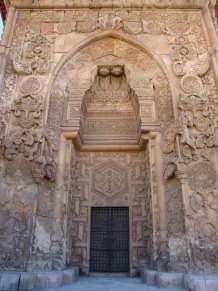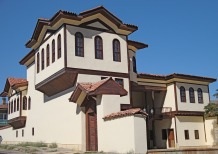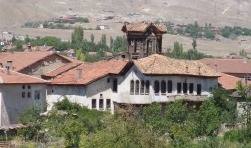Remote world heritage site Population: 10,800
Old name: Tephrike
Market day: Monday & Friday (fruit & veg)
The site of one of Turkey’s UNESCO-designated world heritage sites, Divriği is proof that it can be worth going an awfully long way out of your way in search of something special. For it was here, seemingly in the middle of nowhere, that in 1228 an emir called Ahmed Şah and his wife Turan Melek decided to build a grand complex.
In the 9th century, as Tephrike, a stronghold of the Paulicians, a dualist Armenian sect, Divriği today is a mainly Alevi settlement. For decades it was the town that time forgot but the amount of restoration going on in the older parts of town suggests the intention to open it up to tourism, a project unlikely to get far unless a decent hotel is also opened asap. But with little alternative work to be had in town, Divriği has been losing its population to Sivas. Tourism development could offer a useful lifeline.
Must-see attractions: Ulu Cami and Darüşşıfa, Sikke Malik Türbesi, Abdullah Paşa Konağı
Time on your hands: Cumhuriyet İlkokul, Cedid Paşa Cami, Kale (Castle)
Backstory
Ahmed Şah was one of the Mengüceks, a splinter Turkic tribe that ruled this part of central Anatolia briefly until driven out by the Mongols in 1252. Grown wealthy on the proceeds of the local iron mines, Ahmed was a man with ideas above his station and so he decided to design a mosque and hospital that would outdo anything in Sivas. His ambition ultimately led to such an exuberant outpouring of 3D flora and fauna around the doorways of both buildings that the end product has been dubbed ‘Selçuk Rococo’. It was designed by an architect from Ahlat on the shores of Lake Van.

Around town
 The Ulu Cami and Darüşşıfa complex bestrides the hill a short walk east of the town centre. Here the architects were given free rein to create something without peer, and the result was a crazy outpouring of exuberant stonework in which stars, medallions and inscriptions literally jump out of the framework of the doorways. The most spectacular work adorns the Cennet Kapısı (Gate of Heaven) of the mosque.
The Ulu Cami and Darüşşıfa complex bestrides the hill a short walk east of the town centre. Here the architects were given free rein to create something without peer, and the result was a crazy outpouring of exuberant stonework in which stars, medallions and inscriptions literally jump out of the framework of the doorways. The most spectacular work adorns the Cennet Kapısı (Gate of Heaven) of the mosque.
The effort expended on the entrances appears to have exhausted the architects because the interiors of both buildings are far plainer with the exception of the pillars and capitals of the hospital and the glorious mihrab of the mosque that is carved with what looks like knitted chain stitch but in stone.
You may be unlucky enough to arrive and find the complex locked, but the hospital is certainly worth inspecting for evidence of early New Age-style belief in the healing powers of music. The courtyard comes equipped with a pool designed so that the sound of running water could soothe troubled brows (what a shame that the water has not been reinstalled); a raised ledge nearby is thought to have offered a platform for musicians to supplement its efforts.
To see the mosque it’s best to arrive around prayer times. The hospital is officially open to visitors from 8am to 5pm daily except Mondays. At certain times of day the shadows thrown against the carvings create an astonishingly life-like image of a bowed human figure.
***In 2023 the complex was closed for restoration.***
After exploring the complex you may want to scramble further up the hillside to examine the remains of the medieval castle and the restored Kale (Castle) Camii; both were destroyed by the Mongols in 1252. On the summit an Armenian church has been restored; another lies in ruins beneath the walls.
Divriği has several other reminders of its Mengücek heyday, most conspicuously a number of pointy-headed kümbets (tombs) that, from a distance, look like stone tents planted around town. The finest is the elaborately carved Sitte Malik Türbesi, built between 1194 and 1196. You’ll see it on the hillside close to the start of town.
The shortage of public transport and lack of decent places to stay mean that those without their own wheels may have to content themselves with a quick whirl round the vine-draped bazaar streets before it’s time to head back to Sivas again.
If you can linger it’s worth heading for the Cedidpaşa Mahalle on the opposite side of the valley to the Ulu Cami where whole streets of old Ottoman houses (konaks) survive and are slowly being restored. One of the finest, the Abdullah Paşa Konağı, is being used as a temporary exhibition space until a decision is made about its future.
The elaborately carved doorway of the Cedid Paşa Cami (1799) is thought to have been inspired by the Ulu Cami.
If you have no chance of getting to Divriği you may be interested to know that the architects of the brand-new Sarayburnu Cami at Bulancak on the Black Sea have meticulously copied the Cennet Kapısı (Gate of Heaven).
Eating
Divriği may be short of places to stay but it does better on the eating front. The Konak (Tel: 0346-418 4999) and Hanedan Restaurants in the bazaar are both clean and friendly, and offer a reasonable choice of Turkish staples. 
Sleeping
Divriği is low on places to stay. I have not stayed at the two most promising new hotels.
Divriği Köşk Otel. Tel: 0346-418 4545
Ekin Otel Divriği. Tel: 0346-418 5151
Taşbaşı Belediye Oteli
Theoretically, the best place to stay although the pictures on the website bear no relationship to the actual appearance of the rooms. Ask for one at the back for a great view of the castle although check whether any wedding parties are booked into the adjoining Düğün Salonu (Wedding Hall) if you want an early night. There’s no breakfast, nor so much as a glass of tea available. Forget air-con altogether.
Tel: 0346-418 1825
Özkanlar Pansiyon
Possibly preferable but above a shop right on the road through town so unlikely to be quiet.
Tel: 0346-418 1742
Transport info
There are five daily buses from Sivas to Divriği (175km). To avoid an enforced overnight stay, aim to catch the first one from Sivas in the morning (9am) and reserve a seat for the return as soon as you arrive. The last bus back is usually at 5pm.
The Divriği minbuses leave from the İlce ve Köy Terminali beside the main otogar in Sivas. Phone Divriği Birlik (Sivas: 0346-226 3319; Divriğı: 0346-418 3300) to confirm times.
The road to Divriği winds through remote and beautiful countryside with sunflowers and maize growing in the fields and cattle pasturing. With your own transport you can also drive to Divriği from Kemaliye along a spectacularly beautiful road.
Trains between Sivas and Erzurum also serve Divriği although not at very convenient times. If taking the train, keep an eye out for wild goats on the mountainside, especially in the morning.



